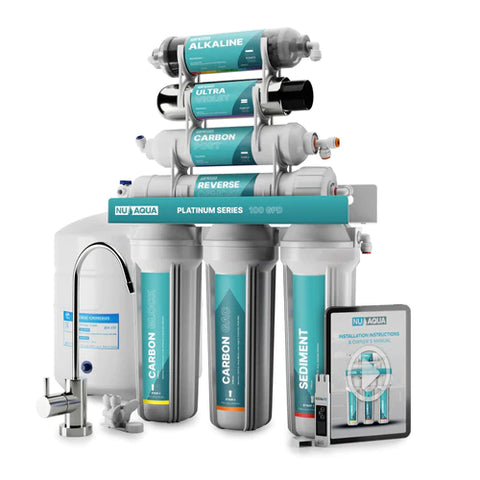Water, essential for life, sustains us all. However, the purity of our water sources faces an unprecedented threat from PFAS, or Per- and Polyfluoroalkyl Substances, commonly known as "forever chemicals." Delve into the topic of PFAS, shedding light on their impact on our water systems, health, and ecosystem. Explore sources of contamination, health concerns, regulations, detection methods, treatment solutions, and steps towards prevention and mitigation.
What are PFAS?
PFAS, or per- and polyfluoroalkyl substances, are synthetic compounds known for their exceptional water and grease resistance. They are utilized in various applications such as non-stick cookware, water-resistant fabrics, firefighting foams, and food packaging. These compounds owe their unique properties to carbon-fluorine bonds, which make them durable and difficult to break down.
Termed "forever chemicals," PFAS earned this label due to their remarkable persistence in the environment. Unlike many pollutants that degrade over time, PFAS compounds remain intact for decades or even centuries. This longevity, while advantageous in certain applications, raises concerns about their impact on water systems and human health.
PFAS encompasses a wide range of individual chemicals, including well-known ones like perfluorooctanoic acid (PFOA) and perfluorooctanesulfonic acid (PFOS). Industries from manufacturing to textiles have employed these compounds for their water and oil repellent properties.
Though prized for their versatility, PFAS carry potential risks for the environment and human well-being. Uncover how PFAS infiltrate water sources and the consequences of their sustained presence on health and ecosystems.
Sources and Pathways of Water Contamination
PFAS contaminate water through various sources:

Industrial Discharges: Improper disposal of manufacturing wastewater releases PFAS into water bodies. Manufacturing processes, such as those involved in producing electronics, textiles, and plastics, often employ PFAS for their desirable properties.

Firefighting Foams: Used to combat flammable liquid fires, these foams can infiltrate groundwater. Firefighting foams, especially those used for suppressing flammable liquid fires, have been a major source of PFAS contamination, particularly at sites like airports, military bases, and industrial facilities.

Landfills and Waste Disposal: When products containing PFAS are discarded, they often end up in landfills or are incinerated. Unfortunately, these disposal methods do not neutralize PFAS, and they can leak into nearby soil and water, potentially seeping into groundwater aquifers. This further amplifies the scope of contamination.

Consumer Products: Leaching from products like stain-resistant carpets and waterproof clothing to microwave popcorn bags and non-stick cookware, these products often contain PFAS to enhance their functionality.
Health and Environmental Concerns
PFAS contamination poses health and environmental risks:
- Cancer: Some studies suggest a potential link between PFAS exposure and certain types of cancer, including kidney, testicular, and thyroid cancers. However, more research is needed to establish conclusive connections.
- Immune System Effects: PFAS exposure has been shown to impact the immune system's function, potentially making individuals more susceptible to infections and diseases.
- Developmental and Reproductive Health: Pregnant women, infants, and children are especially vulnerable to PFAS exposure. Research suggests that exposure during pregnancy could result in adverse outcomes such as low birth weight, developmental delays, and impaired immune system development.
- Liver and Kidney Damage: Some studies have indicated that PFAS exposure can harm liver and kidney function, potentially leading to serious health complications.
- Cholesterol Levels: Certain PFAS compounds are associated with elevated cholesterol levels, which in turn increases the risk of heart disease.
- Aquatic Life: PFAS compounds are toxic to aquatic organisms, impacting fish, amphibians, and other aquatic life. This disruption can have cascading effects throughout food chains.
- Bioaccumulation: PFAS compounds have a tendency to accumulate in living organisms over time, a phenomenon known as bioaccumulation. This means that animals higher up the food chain, including humans, can be exposed to higher concentrations of these chemicals.
- Ecosystem Disruption: The presence of PFAS in water bodies can disrupt ecosystems, affecting plant growth, water quality, and the overall health of ecosystems.
- Global Spread: Due to their persistent nature, PFAS compounds can be transported across borders through air and water currents, leading to contamination in areas far removed from original sources.
Given the potential for lasting harm to both human health and the environment, addressing the PFAS contamination issue is of paramount importance.
Regulations and Guidelines
Recognizing the gravity of the PFAS contamination issue, regulatory agencies around the world have been working to establish guidelines and regulations to address the presence of these chemicals in water sources. However, managing PFAS has proven to be a challenging endeavor due to their persistence, widespread use, and complex pathways of exposure.
Challenges in Regulation: Regulating PFAS is complicated by various factors:
-
Diverse Compounds: The PFAS group comprises thousands of individual compounds, making it challenging to create a one-size-fits-all regulation for all PFAS substances.
-
Lack of Comprehensive Data: Comprehensive data on PFAS contamination levels, health effects, and exposure pathways are still evolving, making it difficult to establish precise regulations.
-
Global Nature of the Issue: PFAS contamination is not confined by borders. These chemicals can be transported globally, requiring international cooperation and harmonization of regulations.
-
Interconnected Industries: PFAS are deeply entrenched in various industries, necessitating careful consideration of economic impacts when implementing regulations.
Recent Developments: Efforts are ongoing to address these challenges and strengthen regulations:
-
Research and Data Collection: Ongoing research is helping to fill knowledge gaps about different PFAS compounds, their toxicity, and their presence in various environments.
-
Legislation and Policies: Some jurisdictions have implemented bans on specific PFAS compounds in consumer products, firefighting foams, and other applications.
-
Collaborative Initiatives: International collaborations are being fostered to share data, best practices, and strategies for managing PFAS contamination.
-
Advancements in Testing: Improved testing methods are being developed to detect a wider range of PFAS compounds in water, soil, and other media.
Treatment and Remediation
As the awareness of PFAS contamination grows, the need for effective treatment and remediation methods becomes increasingly evident. Removing PFAS from water sources is a complex challenge due to their persistence and the diversity of compounds involved. However, innovative technologies are being developed to address this issue and ensure cleaner and safer water supplies.- Treatment Methods: Activated carbon filtration, ion exchange, membrane filtration, AOPs, and bioremediation can remove PFAS from water.
- Challenges and Considerations: PFAS complexity, residue management, cost, scalability, and environmental impact challenge treatment efforts.
NU Aqua Systems' Role: Companies like NU Aqua Systems play a pivotal role in developing and implementing innovative water treatment solutions. NU Aqua leverages cutting-edge technologies to design systems that effectively target PFAS and other contaminants, ensuring that water sources are safe and healthy for communities and ecosystems. Explore the benefits of the reverse osmosis system.
Steps Towards Prevention and Mitigation
Collaborative efforts are vital in addressing PFAS contamination:
- Consumer Awareness: Educate yourself, make informed purchases, and choose PFAS-free products.
- Water Quality Monitoring: Support local monitoring programs and advocate for routine water testing.
- Advocacy for Regulations: Stay informed, engage policymakers, and advocate for stricter PFAS regulations.
- Industry Responsibility: Promote responsible PFAS use, disposal, and invest in safer alternatives.
- Support for Research: Back research initiatives for a better understanding of PFAS contamination.
- Community Engagement: Participate in discussions, stay informed, and engage with local organizations.
- Sustainable Remediation: Advocate for sustainable remediation technologies and cleanup resources.
PFAS contamination demands collective action. By understanding the risks, advocating for regulations, supporting research, and engaging in community efforts, we can contribute to cleaner and safer water sources. The issue is complex, but our combined efforts can lead to a healthier future.
Continue to NU Aqua Systems' Reverse Osmosis Solutions.




